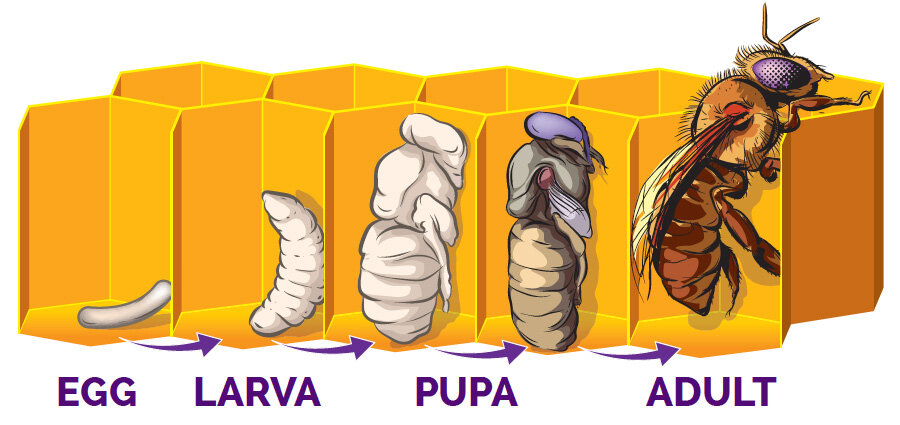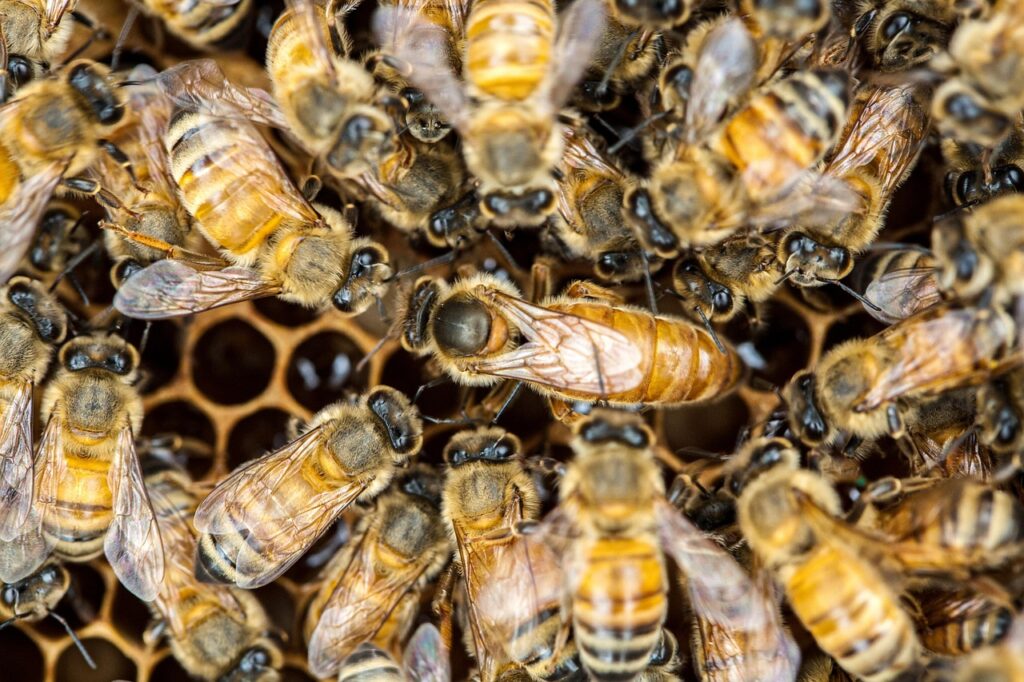A detailed overview of the Life Cycle of the Honey Bee
The honey bee life cycle represents one of nature’s most remarkable examples of complete metamorphosis, showcasing the intricate developmental journey from a tiny egg to a fully functional adult bee.
This comprehensive process involves four distinct stages and varies significantly among the three bee castes within a colony.

Honey bee life cycle showing the four stages of complete metamorphosis with development timelines for queens, workers, and drones.
Overview of Complete Metamorphosis
Honey bees undergo holometabolous development, meaning they experience complete metamorphosis through four distinct stages: egg, larva, pupa, and adult[1][2][3].
This transformation is similar to that of butterflies and other insects, but with unique adaptations specific to social bee colonies.
The entire development occurs within individual hexagonal wax cells of the honeycomb, providing protection and controlled environmental conditions[4][5].

Visual representation of honey bee complete metamorphosis stages
Stage 1: The Egg Stage
Physical Characteristics and Placement
The honey bee life cycle begins when the queen bee lays eggs in individual cells throughout the brood nest[1][6].
These eggs are remarkably small, measuring only 1 to 1.5 millimeters in length—15].
The eggs appear white and oval-shaped, resembling tiny grains of rice, and are initially positioned upright against the base of each cell[7][8].
Development Timeline
The egg stage lasts exactly three days across all bee castes—queens, workers, and drones[1][2][9].
During this period, the egg undergoes critical internal development as the nervous system, digestive system, and outer covering begin to form[6][8].
By the third day, the egg gradually transitions from its upright position to lying on its side as it prepares to hatch[8].
Fertilization and Caste Determination
A crucial aspect of the egg stage involves fertilization, which determines the future caste of the developing bee.
Fertilized eggs develop into female bees (workers or potential queens), while unfertilized eggs become male drones[2][10][6].
The queen has remarkable control over this process, selectively fertilizing eggs based on the size of the cell in which she deposits them[10][6].
Stage 2: The Larval Stage
Physical Transformation
After three days, the egg hatches into a larva—a soft, white, grub-like creature that is blind and legless[1][11][12].
The larvae adopt a characteristic C-shaped position within their cells and are completely dependent on worker bees for care and feeding[13][12].
During this stage, larvae experience extraordinary growth, increasing their body weight by approximately 1,500 times their original size[14][12].
Feeding and Nutrition
The larval feeding program is perhaps the most critical factor determining a bee’s future caste and role within the colony. All larvae initially receive royal jelly for the first few days of life[15][16][17]. However, this nutritional program diverges significantly:
- Queen larvae: Fed exclusively royal jelly throughout their entire larval development (5.5 days)[16][17][18]
- Worker larvae: Receive royal jelly for the first 3 days, then transition to a mixture of pollen, honey, and diluted royal jelly called “bee bread”[16][19][20]
- Drone larvae: Follow a similar pattern to workers but with slightly different nutritional proportions[16][21]
Royal Jelly: The Queen-Making Substance
Royal jelly is a remarkable protein-rich secretion produced by the hypopharyngeal and mandibular glands of nurse bees[16][17][22].
Recent research has revealed that royal jelly serves multiple functions beyond nutrition.
It contains specialized proteins that create a pH-dependent network, allowing queen larvae to remain attached to the roof of vertically oriented queen cells, literally defying gravity during development[22][23][24].
Molting and Instars
During the larval stage, bees undergo a series of molts to accommodate their rapid growth. Honey bee larvae experience five larval instars (developmental stages between molts), shedding their skin multiple times as they grow[25][14].
The larval development timeline varies by caste:
Stage 3: The Pupal Stage
Cell Capping and Cocoon Formation
When larvae reach maturity, worker bees seal their cells with a protective wax capping, marking the transition to the pupal stage[1][2][26].
Immediately after capping, the larva spins a thin silk cocoon within the cell using specialized silk glands[27][28].
his cocoon provides additional protection during the vulnerable transformation period.
Metamorphosis Process
The pupal stage represents the most dramatic transformation in the bee’s life cycle.
Within the protective cocoon and capped cell, the larva undergoes complete reorganization[25][29].
Internal organs are dismantled and reassembled, external features develop, and the characteristic body parts of an adult bee—including wings, legs, antennae, and compound eyes—take shape[30][29].
Development Timeline
The pupal stage duration varies significantly among castes:
Cellular Changes
During pupation, remarkable cellular changes occur throughout the developing bee’s body.
Research has shown that different organs develop at different rates, with brain and head development requiring complex protein interactions and gene expression changes[31][32].
The pupal stage is characterized by high metabolic activity as tissues are reorganized and new structures develop.
Stage 4: The Adult Stage
Emergence Process
Adult bees emerge from their cells by chewing through both the silk cocoon and the wax capping that seals their cell[1][30][29].
This process requires considerable effort, and newly emerged bees (called “callow bees”) initially appear soft and pale before their exoskeleton hardens and darkens[27].
Total Development Time
The complete development timeline from egg to adult varies by caste:
Adult Roles and Lifespan
Adult honey bees assume dramatically different roles based on their caste:
Worker Bees
Worker bees represent the majority of the colony and undergo temporal polyethism—age-based division of labor[34][35][36].
Their roles progress through distinct phases:
- Cell Cleaning (Days 1-2): Newly emerged workers clean cells and prepare them for future use[35][36]
- Nurse Bees (Days 3-12): Care for and feed developing larvae, produce royal jelly[37][35][38]
- Middle-Aged Bees (Days 12-21): Perform various hive maintenance tasks including wax production, nectar processing, and guard duties[37][34][35]
- Foragers (Days 21+): Leave the hive to collect nectar, pollen, water, and propolis[37][39][35]
Worker bee lifespan typically ranges from 4-8 weeks during active seasons, with foraging being the most dangerous phase of their lives[39][40][41].
Research shows that foragers face a constant mortality risk of approximately 9% per hour of foraging and 36% per foraging day[40][42].
Queen Bees
Adult queens focus exclusively on egg production, potentially laying 2,000-3,000 eggs per day during peak season[11][6][33].
Queens can live several years, representing one of the most dramatic lifespan differences in the animal kingdom compared to their genetically identical worker sisters[33][35].
Drones
Male drones have the singular purpose of mating with virgin queens from other colonies.
They typically live only a few weeks to months and are expelled from the hive before winter[43][33][35].
Environmental and Genetic Factors
Temperature Sensitivity
Honey bee development is highly sensitive to temperature variations.
The optimal brood temperature is maintained at 34-36°C (93-97°F) by worker bees[35].
Temperature fluctuations can significantly extend development times and affect adult bee competency[2][31].
Seasonal Variations
Development patterns and adult roles vary seasonally.
Winter bees represent a special generation of workers that live much longer (several months) than summer bees, focusing on colony maintenance and queen care during periods when foraging is impossible[37].
Genetic and Social Influences
Recent research has revealed that pre-adult social environments can have lasting impacts on adult behavior, aggression levels, and even disease resistance[44].
Additionally, environmental stressors can cause precocious foraging, where young bees begin foraging earlier than normal, though this typically results in reduced efficiency and higher mortality[45][46].
The honey bee life cycle represents a masterpiece of biological engineering, combining genetic programming with environmental flexibility to produce a highly efficient social organization capable of surviving in diverse environments and seasons.
⁂
- https://hbrc.ca/stages-of-bee-growth/
- https://beeculture.com/a-closer-look-32/
- https://www.perfectbee.com/learn-about-bees/the-science-of-bees/how-do-honeybees-reproduce
- https://beeswithstories.com/honey-literacy/life-cycle-of-a-honey-bee/
- https://www.sare.org/publications/managing-alternative-pollinators/chapter-three-a-brief-natural-history-of-bees/development-and-reproduction-of-bees/
- https://animals.howstuffworks.com/insects/bee4.htm
- https://www.museumoftheearth.org/bees/biology
- https://sites.google.com/view/livmee/the-metamorphosis-of-the-bee
- https://www.orkin.com/pests/stinging-pests/bees/honey-bees/mechanics-of-honey-bee-mating
- https://www.perfectbee.com/beekeeping-articles/honey-bee-life-cycle
- https://www.apicolturalaterza.com/en/the-metamorphosis-of-a-bee-how-are-bees-born
- https://beeswiki.com/how-do-bees-reproduce/
- https://theholyhabibee.com/bees-life-cycle/
- https://www.youtube.com/watch?v=LM7eEitKcIM
- https://www.orkin.com/pests/stinging-pests/bees/honey-bees/honey-bee-eggs
- https://www.ck12.org/flexi/life-science/agriculture/what-is-the-life-cycle-of-honeybees/
- https://www.pnas.org/doi/full/10.1073/pnas.1703008114
- https://cals.ncsu.edu/news/shedding-light-on-the-secret-reproductive-lives-of-honey-bees/
- https://www.orkin.com/pests/stinging-pests/bees/honey-bees/honey-bee-life-cycle
- https://entnemdept.ufl.edu/media/entnemdeptifasufledu/honeybee/pdfs/abj-field-guide-to-beekeeping/37,-April-2017,-Honey-Bee-Development.pdf
- https://www.youtube.com/watch?v=sCtC8oGEhyk
- https://pubmed.ncbi.nlm.nih.gov/28939335/
- https://www.perfectbee.com/learn-about-bees/the-life-of-bees/how-long-does-it-take-for-an-egg-to-hatch-into-a-honeybee
- https://www.eurekaselect.com/chapter/18469
- https://en.wikipedia.org/wiki/Honey_bee_life_cycle
- https://bellhoney.com/blogs/news/what-is-royal-jelly-and-what-do-bees-use-it-for
- https://journals.plos.org/plosone/article?id=10.1371%2Fjournal.pone.0020428
- https://theapiarist.org/timing-is-everything/
- https://en.wikipedia.org/wiki/Royal_jelly
- http://www.dave-cushman.net/bee/eggdevelop.html
- https://beeculture.com/royal-jelly-worker-bee-produced-protein-rich-mothers-milk/
- https://www.vedantu.com/biology/honey-bee-life-cycle
- https://pmc.ncbi.nlm.nih.gov/articles/PMC5300887/
- https://projects.sare.org/media/pdf/T/h/e/The-life-cycle-of-honey-bees.pdf
- https://repository.up.ac.za/bitstream/handle/2263/66561/Pirk_Honeybee_2018.pdf?sequence=1
- https://idtools.org/thebeemd/index.cfm?packageID=1180&entityID=8533
- https://www.honeybeesuite.com/ultimate-guide-to-bee-cocoons/
- https://agriculture.vic.gov.au/biosecurity/pest-insects-and-mites/priority-pest-insects-and-mites/wax-moth-a-beekeeping-pest
- https://beeinspiredgoods.com/blogs/beekeeping/processing-beeswax
- https://www.beeculture.com/a-closer-look-32/
- https://beeinformed.org/2021/07/02/detecting-wax-moth-larvae-in-frames-of-sealed-brood/
- https://www.premierbeeproducts.com/shop/shallow-extra-heavy-wax-1
- https://americanbeejournal.com/the-puzzling-pupa-and-its-cryptic-cocoon/
- https://www.beeculture.com/a-closer-look-33/
- https://www.honeybeesuite.com/wet-cappings-vs-dry-cappings/
- https://www.thorne.co.uk/blog/ask-the-expert/have-you-ever-seen-a-honeybee-cocoon


